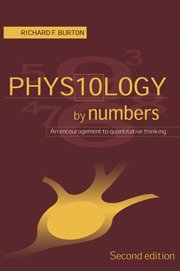Book contents
- Frontmatter
- Contents
- Preface to the second edition
- Preface to the first edition
- How to use this book
- 1 Introduction to physiological calculation: approximation and units
- 2 Quantifying the body: interrelationships amongst ‘representative’ or ‘textbook’ quantities
- 3 Energy and metabolism
- 4 The cardiovascular system
- 5 Respiration
- 6 Renal function
- 7 Body fluids
- 8 Acid–base balance
- 9 Nerve and muscle
- Appendix A Some useful quantities
- Appendix B Exponents and logarithms
- References
- Notes and Answers
- Index
Preface to the first edition
Published online by Cambridge University Press: 06 July 2010
- Frontmatter
- Contents
- Preface to the second edition
- Preface to the first edition
- How to use this book
- 1 Introduction to physiological calculation: approximation and units
- 2 Quantifying the body: interrelationships amongst ‘representative’ or ‘textbook’ quantities
- 3 Energy and metabolism
- 4 The cardiovascular system
- 5 Respiration
- 6 Renal function
- 7 Body fluids
- 8 Acid–base balance
- 9 Nerve and muscle
- Appendix A Some useful quantities
- Appendix B Exponents and logarithms
- References
- Notes and Answers
- Index
Summary
Let us therefore take it that in a man the amount of blood pushed forward in the individual heartbeats is half an ounce, or three drams, or one dram, this being hindered by valves from re-entering the heart. In half an hour the heart makes more than a thousand beats, indeed in some people and on occasion, two, three or four thousand. Now multiply the drams and you will see that in one half hour a thousand times three drams or two drams, or five hundred ounces, or else some such similar quantity of blood, is transfused through the heart into the arteries – always a greater quantity than is to be found in the whole of the body.
But indeed, if even the smallest amounts of blood pass through the lungs and heart, far more is distributed to the arteries and whole body than can possibly be supplied by the ingestion of food, or generally, unless it returns around a circuit.
William Harvey, De Motu Cordis, 1628 (from the Latin)In more familiar terms, if the heart beats, say, 70 times a minute, ejecting 70 ml of blood into the aorta each time, then more fluid is put out in half an hour (1471) than is either ingested in that time or contained in the whole of the body. Therefore the blood must circulate. Thus may the simplest calculation bring understanding.
- Type
- Chapter
- Information
- Physiology by NumbersAn Encouragement to Quantitative Thinking, pp. xi - xivPublisher: Cambridge University PressPrint publication year: 2000



